When I started writing about beer, it was because I was trying to establish some credentials in order to get into brewing school. I did manage, subsequently, to get into brewing school, but then there was a book deal. I found that commuting 5 hours a day to Niagara College and writing a book didn’t mix particularly well. I don’t believe that you can get a book written on a Coach Canada bus, especially when you factor in the 5:30 am start to the day and the slight nausea that comes with that kind of travel.
Eventually, the book about brewing (You can buy a copy by clicking the link to the right!) won out. It’s a difficult thing. Having now written the book, I’m convinced that I could do it in a shorter amount of time. At the time, the sense of deadline related panic rendered it a full time occupation. After all, the only way to learn how to write a book is to write a book.
I continue to enjoy brewing. There are the wonderful aromas that you only get in a brewhouse. After eight months away from it, even the sharp vinegar whiff of the paracetic acid used for sterilizing equipment conjures up a temporal sense of place. You get the aroma off the kettle five minutes after the first hop addition, and that’s a marvelous smell. There’s the edifying sense in that aroma that you’re accomplishing something. You’re making something that will, if everything goes right, give a number of people a small pleasure at the end of their day.
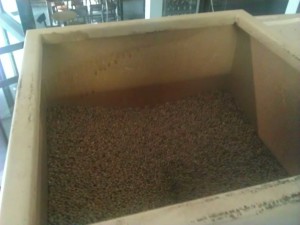
Freshly milled grain is one of those healthy smells that I think we’re all sort of programmed to recognize.
It was for this reason that I put up a notice on facebook a short while ago that I missed brewing, and would any generous Ontario breweries like to host a one-off collaboration. It got slightly more response than I suspected that it would. No fewer than four breweries came forward to suggest that I could work with them on a project.
Faced with that potential, the seemingly ideal thing to do would be to thank your lucky stars that anyone is interested and then maybe choose one of those four breweries to work with. I gave the calendar a glance and realized that Toronto Beer Week is coming up, meaning that the beer writer’s Barrel Bragging Rights event was right around the corner.
Last year, Josh Rubin from the Toronto Star won with a pretty nifty Dopplebock that reminded me of nothing so much as Schloss Eggenberg’s version. It was an absolute corker. This year, I wanted to beat Josh Rubin if only to maintain the completely fictional inter-newspaper rivalry that we enjoy as banter. I decided that the thing to do was to create four one off beers so that I could choose the one that was most likely to be successful served out of an oak barrel. After all, Rubin must be crushed!
The only problem is that I haven’t heard anything about the Barrel Bragging Rights competition this year, and I believe it may be taking a short hiatus until 2014. Perhaps you’re beginning to see the problem: Four beers and no event at which to serve them.
It was at that point that I decided to create my own event for Toronto Beer Week: The Feast of St.John.
The intent here is to host a four course beer dinner in which all of the beer and food is designed from the ground up to fit into a cohesive menu with a progression from start to finish. I’ve been to beer dinners where the chef has to fit the menu to the beer. I’ve also talked with Garrett Oliver from Brooklyn a little bit about how he created a beer specifically to go with a roast chicken at NoMad in New York.
I don’t know that anyone has tried to pull off an event like this before. I figure I’m qualified, what with a certain amount of training as a brewer, a Certified Cicerone designation and a pretty decent depth of food knowledge. I’ve got a great cook to work with and a venue to host it in. Plus, why the heck wouldn’t you do it? I mean, it’s not exactly like you’re going to take a credibility hit for trying something really difficult. The details are still coming together, but brewing began on Friday.
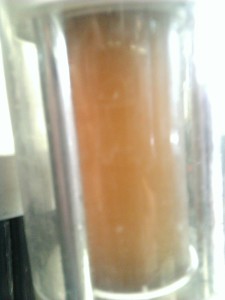
The marzen will eventually be approximately this colour. I love that bright orange melanoidin burst.
The first beer is a collaboration with The Beer Academy, which now occupies the downtown brewpub location that housed Duggan’s and, once upon a time, Growler’s. It’s going to be a Marzen, which should be just the thing for mid to late September with Oktoberfests popping up all over the place. I was a little surprised that they’d let me try my hand at a lager, what with the longer aging time and the fact that lagers just aren’t very trendy at the moment.
Sometimes it seems that if you want to sell a beer these days, you’ve got to get a gimmick. With the prevalence of IPAs and the number of sub-varieties that the style has spawned (white, black, double, imperial) the big bitter kick is pretty popular. I confess to a certain amount of fatigue on that front. There are only so many times you review vastly similar things without wearing out your vocabulary and attention span.
During the planning meeting, we were looking for a style of beer. One of the things that you need to know about The Beer Academy is that rather than working with brand new state of the art equipment as you’d expect at a Molson owned property, they’re using the equipment that came with the building when they took over.
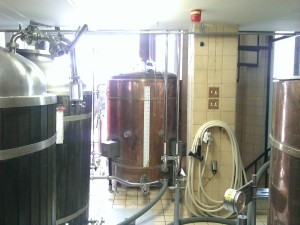
One of the things that struck me about brewing at the Beer Academy is the care being taken of the equipment. They’re very respectful of it.
I believe that Growlers was started in 1989, so some of that stuff is probably nearly a quarter century old at this point. The fermenters are what I guess you’d call round bottomed grundy tanks, which are pretty much what there was at the time. Round bottoms mean that dry hopping is going to be messy, so they tend not to make beers that would require it. Additionally, the boil kettle is electric, meaning that you do get a small amount of smoky flavour as a house character because of hotspots.
Given that information about the system, you want to work with it instead of trying to force it to do something it’s not suited to. If you look at the lineup that was featured at Growlers, it heavily featured German styles. Marzen was a great choice, even if it’s slightly intimidating to be doing that on Michael Hancock’s old equipment.
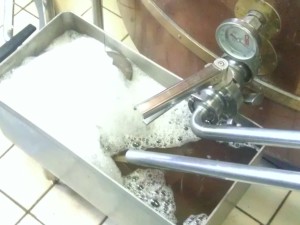
This is really clever. They have produced a grant for the mash tun that operates on a float arm and empties once it reaches a certain fill level. It’s the same principle as a toilet tank and it means that you can safely ignore the exact rate of flow. Very clever.
We came up with a malt bill that is a pretty standard blend of floor malted bohemian pilsner and some slighty more melanoidin heavy malt for colour and flavour. In addition to doing the typical beer collaboration photo op activities like hoisting grain into the mill and raking out the mash tun, I got to choose the hop bill on the day. I went with three varieties of hallertauer and some saaz. The neat thing about the hallertauer varieties are that they’re pretty humulene heavy noble hops and provide some woody, spicy notes on the palate. We used Hersbrucker and Tradition for the boil, but found a lovely variety of New Zealand hallertauer in the hop room that has that signature mineral and tropical fruit kick that you get out of New Zealand hops. The saaz is there because I like that peppery aroma and I’m hoping that it’ll provide some depth of flavour without confusing the issue.
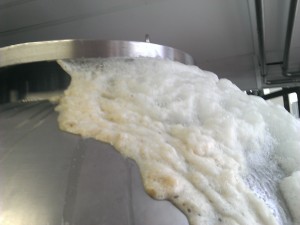
At some point during the brew day, the previous day’s Belgian Tripel kicked into overdrive. Krausen cascades all the way to the floor.
From the point of view of pairing with food, Marzen comes with a cultural heritage you can’t ignore. The hope is that the aroma from the New Zealand hallertauer will open up some options to expand on German tradition.
Thanks go to the nice folks at The Beer Academy. Stephen, for displaying the depth of his beer nerdery during planning by whipping out the smartphone BJCP app. Quentin, for walking me through what is basically a refresher course after a year away from brewing. Todd, for handling the calculations and for letting me in the building in the first place.
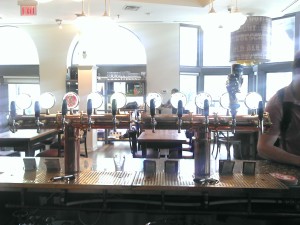
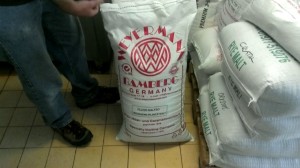
Jordan, nice project! Don’t be intimidated by the bottom feeders, you should turn out a great beer! I started doing the German winter brew cycle as a homebrewer a few years ago as an exercise. Never having been a big fan of most lager styles, what I learned is not only how to make decent traditional lagers, but also how much I like them. I am now producing a very solid Kellerbier every year to get me through the summer.
I have a small keg of my Marzan lagering for the fall festival season. I’m sure it’s not old world brilliant, but past years have turned out well. I ferment in the garage in the cool of March and lager in the basement refrigerator until it’s time to enjoy. I’d be glad to share a bottle for cross tasting when you are ready. For curiosity purposes of course…;-)